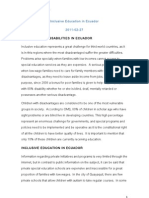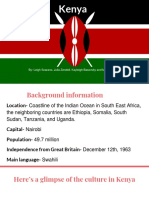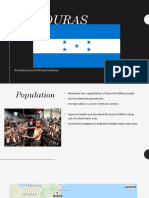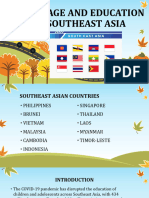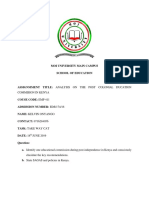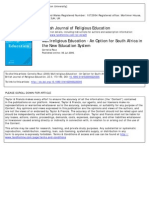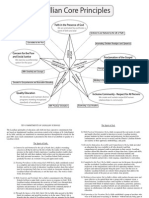0 ratings0% found this document useful (0 votes)
36 viewsKenya
Kenya
Uploaded by
api-262715288Copyright:
© All Rights Reserved
Available Formats
Download as PPTX, PDF, TXT or read online from Scribd
Kenya
Kenya
Uploaded by
api-2627152880 ratings0% found this document useful (0 votes)
36 views14 pagesOriginal Title
kenya
Copyright
© © All Rights Reserved
Available Formats
PPTX, PDF, TXT or read online from Scribd
Share this document
Did you find this document useful?
Is this content inappropriate?
Copyright:
© All Rights Reserved
Available Formats
Download as PPTX, PDF, TXT or read online from Scribd
Download as pptx, pdf, or txt
0 ratings0% found this document useful (0 votes)
36 views14 pagesKenya
Kenya
Uploaded by
api-262715288Copyright:
© All Rights Reserved
Available Formats
Download as PPTX, PDF, TXT or read online from Scribd
Download as pptx, pdf, or txt
You are on page 1of 14
KENYA
Lauren Fl yge, Cyndy Leonard, Mike McCabe
GEOGRAPHY
Located in East Africa
Twice the size of Nevada
Cut by the Equator
Surrounded by: Ethiopia, Tanzania, Somalia, Uganda, South Sudan
East side: coastlines and swamps
Central and west: Kenyan rift valley (highest mountains)
Some small forests
Tropical climate
Arid climate
Geography
Politics
Democratic republic- The Republic of Kenya
Capital: Nairobi
Current President: Uhuru Kenyatta
Kenya won its independence from British colonial rule in 1963
The country has a multi-party political system
CULTURE
A melting pot of people
Waves of migration have led to Kenya becoming one of the most diverse African
countries culturally and linguistically.
The country has at least 40 different ethnic African groups
Kenya is also home to large populations of Europeans, Arabs, Indians and Pakistanis.
http://www.our-africa.org/kenya/people-culture
Video of two children talking about different tribes and their own beliefs and customs.
While your watching keep this question in mind:
What are some differences between the African tribes mentioned?
Belief systems among some remote tribes also remain indigenous.
Across Kenya, a whole two-thirds of people are Christian.
With the centuries-old influence of Arabic and Islamic traders and settlers around 15% of Kenyans
are Muslim.
https://www.youtube.com/watch?v=wrDFYiU9Cd8
Ethnicity/Culture
Education
Kenya has a developed education system:
8 years of primary
4 years of secondary
4 years of university education
It is undergoing slow but sure development through the effort of the government.
There are a number of schools in Kenya including international schools that incorporate:
American
British
French
German
Kenyan Universities:
seven National universities and a number of private universities
some national polytechnics
17 institutes of technology
12 technical training institutes
Education Statistics
About 85% of all Kenyan children attend free primary school
24% children attend secondary school
2% attend higher education institutions
The average age of children entering primary school in Kenya is 6.
Approximately 5.8% of children in primary school will have to repeat a grade.
Only about 83.6% of children who enter primary school, will survive to the last grade.
Adult (age 15+) literacy rate in Kenya is about 87%
Youth (age 15 24) literacy rate in Kenya is about 92.7%
Government Influence on Education
The Kenyan government made a promise to provide free primary education to its citizens.
This promise did not materialize till 2003, due to the low economy and increasing population of
Kenya.
The 8-4-4 system was introduced in 1985.
Activity
Use the Venn Diagram to compare and contrast the culture and education of Kenya
and the United States (in general).
Think about diversity/ethnicity, education programs, statistics.
Co-teaching and Learning Styles
Learning Styles:
Applied
Spatial
Co-teaching:
Team teaching
Parallel
Resources
http://www.our-africa.org/kenya/people-culture
http://unmilleniumdevelopmentgoal.wordpress.com/2011/12/12/education-statistics-
canada-versus-ethiopia/
http://www.mapsofworld.com/kenya/education/
http://www.kenyarep-jp.com/kenya/government_e.html
http://en.wikipedia.org/wiki/Geography_of_Kenya
You might also like
- Kanda Puranam of KachiapparDocument4 pagesKanda Puranam of KachiapparSivason100% (1)
- Special Education in Ecuador (Paper)Document7 pagesSpecial Education in Ecuador (Paper)Ana Maria NuñezNo ratings yet
- Mexico Educational System Curriculum and InstructionDocument46 pagesMexico Educational System Curriculum and InstructionRaymark D. Llagas100% (1)
- Comparative Study of Education in Kenya and Japan: What Can Kenya Learn?Document25 pagesComparative Study of Education in Kenya and Japan: What Can Kenya Learn?dulluamos78% (27)
- Tazkara-tul-Aulia (Memories of The Saints)Document336 pagesTazkara-tul-Aulia (Memories of The Saints)Iftekhari_silsila100% (5)
- Rukmini's Letter - Word For Word in EnglishDocument6 pagesRukmini's Letter - Word For Word in EnglishadiyendasNo ratings yet
- A Field Trip Report of Bachelor of Tourism ManagementDocument74 pagesA Field Trip Report of Bachelor of Tourism Managementਗਾਬਾ ਸਾਬ79% (14)
- (Makdisi) Religion and Culture in Medieval IslamDocument25 pages(Makdisi) Religion and Culture in Medieval IslamHajar AlmahdalyNo ratings yet
- KenyaDocument11 pagesKenyaapi-475025195No ratings yet
- Kenya PowerpointDocument11 pagesKenya Powerpointapi-475025139No ratings yet
- KenyaDocument11 pagesKenyaapi-475025041100% (1)
- KenyaDocument11 pagesKenyaapi-475025036No ratings yet
- Final KenyaDocument34 pagesFinal Kenyaapi-121983938No ratings yet
- System of Education in Selected Countries of The COUNTRY FinalDocument61 pagesSystem of Education in Selected Countries of The COUNTRY Finalalleli dela cruzNo ratings yet
- South Africa and Kenya Report2Document12 pagesSouth Africa and Kenya Report2Aileen SalameraNo ratings yet
- The Education System and Practices in Canada-EM 502Document25 pagesThe Education System and Practices in Canada-EM 502Mildred Reyes MorenoNo ratings yet
- Kenya EducationDocument6 pagesKenya Educationapi-265887966No ratings yet
- Honduras 1Document19 pagesHonduras 1api-393430354No ratings yet
- Country: Education System: AustraliaDocument33 pagesCountry: Education System: AustraliaLanie MarcellaNo ratings yet
- India: Aanis Khan Shivani AgrawalDocument13 pagesIndia: Aanis Khan Shivani AgrawalAanis KhanNo ratings yet
- Crossing Cultures: It's Everyone's BusinessDocument34 pagesCrossing Cultures: It's Everyone's BusinessAmarendra KumarNo ratings yet
- Comparative Education 27th May 2016Document36 pagesComparative Education 27th May 2016CorneliusNo ratings yet
- EDCC 423 Study Unit 8 MalaysiaDocument22 pagesEDCC 423 Study Unit 8 MalaysiakopanomakhobaNo ratings yet
- Education of KenyaDocument29 pagesEducation of Kenyagbunta35No ratings yet
- India: Uttama Nag Kristin Perry Marlene SedaDocument13 pagesIndia: Uttama Nag Kristin Perry Marlene Sedaswatisharma_licNo ratings yet
- EDUC 5010 Writing Unit 2Document6 pagesEDUC 5010 Writing Unit 2jgokcedagNo ratings yet
- The Philippine Educational SystemDocument39 pagesThe Philippine Educational SystemJoan Leorna100% (1)
- Education Commissions in Kenya - TPDFDocument18 pagesEducation Commissions in Kenya - TPDFd cNo ratings yet
- Social Studies EOY NotesDocument31 pagesSocial Studies EOY NotesKaixin HuangNo ratings yet
- Cote D'ivoireDocument32 pagesCote D'ivoireSol100% (1)
- Truth & Reconciliation: University of British Columbia SEPTEMBER 16-22, 2013Document8 pagesTruth & Reconciliation: University of British Columbia SEPTEMBER 16-22, 2013Ali KalyarNo ratings yet
- Content:: - Republic of Kenya - National Flag - Demographics - National Animal - Sport Representation - Popular PersonDocument16 pagesContent:: - Republic of Kenya - National Flag - Demographics - National Animal - Sport Representation - Popular PersonAbdulqadir NajmiNo ratings yet
- Kenyan Education System Notes-1Document7 pagesKenyan Education System Notes-1Enoch KurrNo ratings yet
- Education 2024Document47 pagesEducation 2024sleosimeka3bNo ratings yet
- Education System in KenyaDocument9 pagesEducation System in Kenyajoyceonyango2022No ratings yet
- Broadening Teaching Perspectives - Teacher Exchange ProgramsDocument18 pagesBroadening Teaching Perspectives - Teacher Exchange ProgramsMila GamidoNo ratings yet
- Lecture Three Power Point PresentationDocument23 pagesLecture Three Power Point PresentationLihle DoctorNo ratings yet
- Global Perspectives of Curriculum DevelopmentDocument16 pagesGlobal Perspectives of Curriculum DevelopmentHina KaynatNo ratings yet
- Population EducationDocument38 pagesPopulation EducationMukul Saikia100% (1)
- International Literacy Day 2020: National Literacy Mission AuthorityDocument14 pagesInternational Literacy Day 2020: National Literacy Mission AuthorityLakshmiNo ratings yet
- Topic 6 Education in South Africa Part II - 8Document30 pagesTopic 6 Education in South Africa Part II - 8nichole_ncNo ratings yet
- LPPMS-GR 2Document44 pagesLPPMS-GR 2mercybelleabadNo ratings yet
- People For Education Annual Report 2012 - Embargoed Until 4am May 28 2012Document62 pagesPeople For Education Annual Report 2012 - Embargoed Until 4am May 28 2012jamie_long6959No ratings yet
- Today's State of EducationDocument11 pagesToday's State of EducationJayesh ChaudhariNo ratings yet
- IrelandDocument11 pagesIrelandapi-341977229No ratings yet
- Comparative Education 17th May 2016 2Document31 pagesComparative Education 17th May 2016 2CorneliusNo ratings yet
- Comparative Education 17th May 2016 2 3Document28 pagesComparative Education 17th May 2016 2 3CorneliusNo ratings yet
- Education For Development and Democracy - Annual Report National Security Council Peace CorpsDocument66 pagesEducation For Development and Democracy - Annual Report National Security Council Peace CorpsAccessible Journal Media: Peace Corps DocumentsNo ratings yet
- Malnutrition in KenyaDocument8 pagesMalnutrition in Kenyaadwitibts16No ratings yet
- South AfricaDocument51 pagesSouth Africadyslazo043No ratings yet
- EMP Assignment KELVINDocument5 pagesEMP Assignment KELVINKennethNo ratings yet
- Education in New ZealandDocument6 pagesEducation in New Zealandabdallah.sawyNo ratings yet
- Inequality in EducationDocument33 pagesInequality in Educationamethyst91_babe5900100% (2)
- History-of-Phil - Educ. 2022Document46 pagesHistory-of-Phil - Educ. 2022Jerome ToraldeNo ratings yet
- Foundations of Education 831 - Unit 9 Problems and Issues of Education in Pakistan - Dr. Zaheer AhmadDocument34 pagesFoundations of Education 831 - Unit 9 Problems and Issues of Education in Pakistan - Dr. Zaheer Ahmadumme ammaraNo ratings yet
- Moi Girls Eldoret School ProfileDocument6 pagesMoi Girls Eldoret School ProfileDandi TilahunNo ratings yet
- African Education NYDocument3 pagesAfrican Education NYstrangeralvinNo ratings yet
- Education in Equatorial Guinea - WikipediaDocument4 pagesEducation in Equatorial Guinea - WikipediajosephsenassouaNo ratings yet
- Malaysia LiteracyDocument22 pagesMalaysia LiteracyEspinosa GretchielNo ratings yet
- The Philippine Education System NotesDocument70 pagesThe Philippine Education System Notesrose ann may100% (1)
- Sociological Factors in EducationDocument22 pagesSociological Factors in EducationJulie Ann FabiconNo ratings yet
- British Journal of Religious Education: An Option For South Africa inDocument9 pagesBritish Journal of Religious Education: An Option For South Africa inpatricioafNo ratings yet
- Reasons Why Aboriginal Worldviews MatterDocument20 pagesReasons Why Aboriginal Worldviews MatterErika AlNo ratings yet
- African Education ComparativeDocument4 pagesAfrican Education ComparativeRODOLFO Jr CASSANOVANo ratings yet
- Ell Classroom Observation ReportDocument3 pagesEll Classroom Observation Reportapi-262715288No ratings yet
- Ell BrochureDocument2 pagesEll Brochureapi-262715288No ratings yet
- Silent Skit ReflectionDocument2 pagesSilent Skit Reflectionapi-262715288No ratings yet
- Ell PowerpointDocument10 pagesEll Powerpointapi-262715288No ratings yet
- GB Activities Midterm Mota ReadingLiteraryTextDocument6 pagesGB Activities Midterm Mota ReadingLiteraryTextJessa Mhay MotaNo ratings yet
- Basaveshwara InformationDocument2 pagesBasaveshwara InformationJasvinder SinghNo ratings yet
- Veritas Summer 2009 EditionDocument24 pagesVeritas Summer 2009 Editiondlobelle100% (2)
- Doctor Faustus Test-1Document24 pagesDoctor Faustus Test-1Ellita Permata AnwarNo ratings yet
- Lasallian Core PrinciplesDocument2 pagesLasallian Core PrinciplesBrchuduNo ratings yet
- ASSIGNMENT - APJ Abdul KalamDocument2 pagesASSIGNMENT - APJ Abdul Kalamridvikaarora16No ratings yet
- QuranDocument72 pagesQuranMuhammad HassanNo ratings yet
- HO For CFE102 MIDTERMDocument4 pagesHO For CFE102 MIDTERMDeborah Kilongan CalpoNo ratings yet
- Prosperity MeditationDocument3 pagesProsperity Meditationevkaevka100% (1)
- 5th HouseDocument7 pages5th HousesainergyNo ratings yet
- The Relationship Between Mbira Dzavadzimu Modes and Zezuru Ancestral Spirit PossessionDocument143 pagesThe Relationship Between Mbira Dzavadzimu Modes and Zezuru Ancestral Spirit Possessionsingingdrum100% (3)
- Education 2008Document66 pagesEducation 2008meghraj01No ratings yet
- Madrasah Alive and Special Interest ProgramsDocument2 pagesMadrasah Alive and Special Interest Programsgiadocallas24No ratings yet
- Pasuram 15 of Andal's ThiruppavaiDocument11 pagesPasuram 15 of Andal's Thiruppavaivlaxmanan100% (1)
- Watchtower: Cause of Death by J.F. Rutherford, 1932Document68 pagesWatchtower: Cause of Death by J.F. Rutherford, 1932sirjsslut100% (1)
- The Codification of Muslim Personal Status Laws: A Blessing or A Curse?na El RobyDocument15 pagesThe Codification of Muslim Personal Status Laws: A Blessing or A Curse?na El RobyirfkustNo ratings yet
- EthicsDocument9 pagesEthicssonnetthomasNo ratings yet
- The Hyparxis of The Dramatic Universe PDFDocument7 pagesThe Hyparxis of The Dramatic Universe PDFKedar KelkarNo ratings yet
- One Planet Worth Keeping Zeer ParryDocument2 pagesOne Planet Worth Keeping Zeer ParrygreattrekNo ratings yet
- Directory of Institutes of Consecrated Life Present in MindanaoDocument49 pagesDirectory of Institutes of Consecrated Life Present in MindanaoDegee GonzalesNo ratings yet
- Literature - So Puritan - Sidney Gosson - SoDocument2 pagesLiterature - So Puritan - Sidney Gosson - SoTouseef Ul Hassan MammarNo ratings yet
- District Waqf Officer Merit ListDocument78 pagesDistrict Waqf Officer Merit ListIDRIS KHANNo ratings yet
- Towards Understanding The Peoples of The CordilleraDocument288 pagesTowards Understanding The Peoples of The CordilleraDebbie PachaoNo ratings yet
- Jacques Vallee - Messengers of Deception - UFO Contacts and Cults (1979)Document272 pagesJacques Vallee - Messengers of Deception - UFO Contacts and Cults (1979)DirkTheDaring1194% (17)
- Astrology BasicsDocument50 pagesAstrology BasicsMahesh KurallaNo ratings yet

